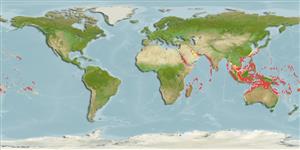>
Eupercaria/misc (Various families in series Eupercaria) >
Labridae (Wrasses) > Pseudodacinae
Etymology: Pseudodax: Greek,pseudes = false + Greek, odax, = with the teeth (Ref. 45335).
More on author: Valenciennes.
Environment: milieu / climate zone / depth range / distribution range
Écologie
marin récifal; profondeur 3 - 60 m (Ref. 9823), usually 4 - 40 m (Ref. 27115). Tropical; 24°C - 28°C (Ref. 27115); 32°N - 24°S
Indo-Pacific: Red Sea to South Africa (Ref. 35918) and to the Society, Marquesan and Tuamoto islands, north to southern Japan.
Taille / Poids / Âge
Maturity: Lm ? range ? - ? cm
Max length : 30.0 cm TL mâle / non sexé; (Ref. 30573)
Épines dorsales (Total): 11; Rayons mous dorsaux (Total): 12; Épines anales 3; Rayons mous anaux: 14
Inhabits clear channels and seaward reefs (Ref. 9710). Juveniles are commonly found along drop-offs below 18 m (Ref. 9710). Adults usually found near caves while juveniles frequently live inside them. Adults are solitary and feed on algae and small invertebrates. Juveniles have been observed 'cleaning' other fishes. Because of its dentition, it is regarded as a close relative to the parrotfishes (Scaridae), although it behaves like the species of Anampses.
Life cycle and mating behavior
Maturité | Reproduction | Frai | Œufs | Fécondité | Larves
Oviparous, distinct pairing during breeding (Ref. 205).
Westneat, M.W., 2001. Labridae. Wrasses, hogfishes, razorfishes, corises, tuskfishes. p. 3381-3467. In K.E. Carpenter and V. Niem (eds.) FAO species identification guide for fishery purposes. The living marine resources of the Western Central Pacific. Vol. 6. Bony fishes part 4 (Labridae to Latimeriidae), estuarine crocodiles. FAO, Rome. (Ref. 9823)
Statut dans la liste rouge de l'IUCN (Ref. 130435)
Menace pour l'homme
Harmless
Utilisations par l'homme
Pêcheries: intérêt commercial mineur; Aquarium: Commercial
Plus d'informations
RéférencesAquacultureProfil d'aquacultureSouchesGénétiqueElectrophoresesHéritabilitéPathologiesTraitementNutrientsMass conversion
CollaborateursImagesStamps, Coins Misc.SonsCiguateraVitesseType de nageSurface branchialeOtolithesCerveauxVision
Outils
Articles particuliers
Télécharger en XML
Sources Internet
Estimates based on models
Preferred temperature (Ref.
123201): 25.5 - 29, mean 28 °C (based on 1384 cells).
Phylogenetic diversity index (Ref.
82804): PD
50 = 1.0000 [Uniqueness, from 0.5 = low to 2.0 = high].
Bayesian length-weight: a=0.01122 (0.00514 - 0.02450), b=3.04 (2.87 - 3.21), in cm total length, based on all LWR estimates for this body shape (Ref.
93245).
Niveau trophique (Ref.
69278): 2.8 ±0.26 se; based on food items.
Résilience (Ref.
120179): Milieu, temps minimum de doublement de population : 1,4 à 4,4 années (Preliminary K or Fecundity.).
Fishing Vulnerability (Ref.
59153): Low vulnerability (20 of 100).
Nutrients (Ref.
124155): Calcium = 56.2 [32.6, 88.7] mg/100g; Iron = 0.621 [0.367, 1.129] mg/100g; Protein = 18.2 [15.4, 20.4] %; Omega3 = 0.136 [0.091, 0.207] g/100g; Selenium = 32.2 [20.4, 54.9] μg/100g; VitaminA = 98.8 [30.2, 359.3] μg/100g; Zinc = 1.6 [1.2, 2.6] mg/100g (wet weight);
